A Chance to Play “Tourist” Again
This week we made our first “tourist” outing in several months. Back in December we spent several days in Lisbon scouting for a new apartment and ever since we had been eager to see more of the city.
To get us started, Mary consulted our favorite travel guide, Rick Steves. In his Portugal guidebook, Rick suggests several walking tours of Lisbon neighborhoods – Baixa, Chiado, and Alfama.
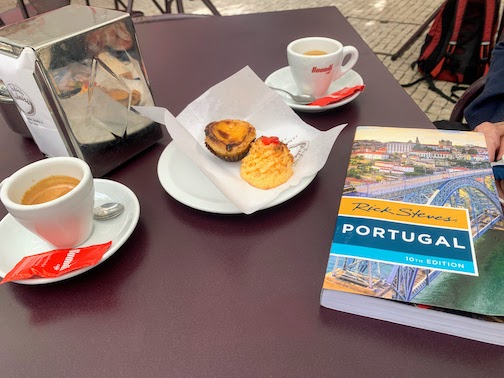
Mary decided we should start with a trip to Alfama, in the southeast corner of Lisbon. We had been on the periphery of the neighborhood during our scouting trip, so it felt like we were starting from a familiar place.
Some Background on Alfama
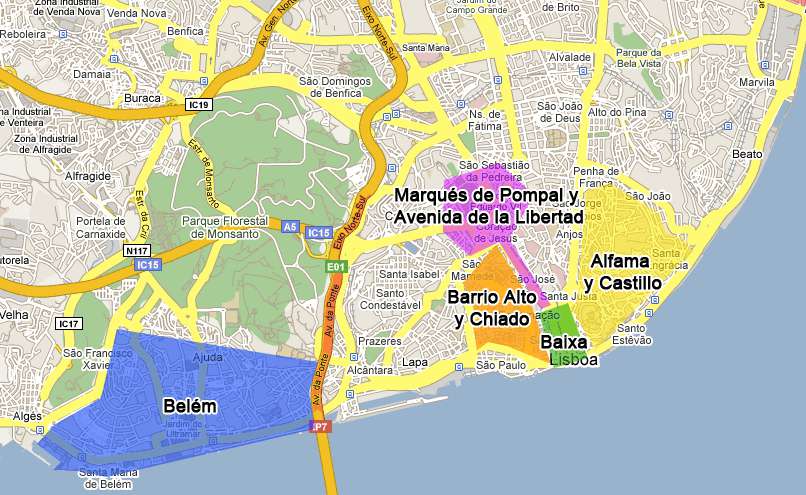
Alfama is one of the oldest areas in LIsbon. When a major earthquake leveled much of Lisbon in 1755, Alfama was damaged, but not destroyed. Visiting the area today gives you a view of what the city was like in pre-earthquake times. Many of the buildings date back into the middle ages or earlier.
This area was occupied by the Moors from the 8th century until the 12th. In the 10th century they built a large castle at the top of a steep hill. The streets leading up to the castle are steep, narrow, winding, and paved with large calçadas – Portuguese cobblestones.
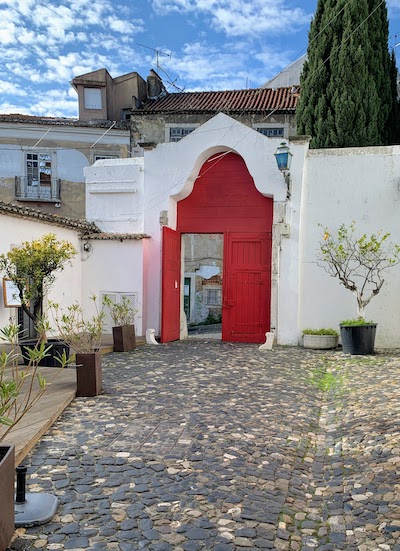
We took a trolley up the hill to the Castelo de São Jorge – the castle of Saint George. In 1147 the castelo was captured by Christian Crusaders, led by Afonso Henriques, who later became the first king of Portugal. Portuguese royalty lived in the castle for several centuries.
The earthquake damaged the castle, but it was repaired and later housed a military garrison. In the 20th century it was named a national monument. We read several descriptions that said the interior of the castle is very stark and uninteresting, so we skipped the €8.50 entry fee and spent our time walking through the small neighborhood inside the castle’s outer walls.
Exploring Castle Town
You enter the castle compound through a large stone arch. Immediately inside is a niche containing a small statue of Sao Jorge, the castle’s namesake.


Within the walls is a small neighborhood known as Castle Town. The original inhabitants were Moorish elites, who sought protection inside the castle walls. Later it was home to Portuguese nobles who wanted to live near the king.
People were a lot smaller back when these houses were built. Many of them had doors that were much shorter than what we see today. Mary thought that these doors, like her, were “fun sized”.

Down the hill, slowly
After we left the castelo, we walked back down the hill, being careful about where we stepped on the uneven paving stones. Rick Steves described the layout as a “labyrinthine street plan [that] was designed to frustrate invaders”. But what was an intentional barrier to 12th century armies is a benefit for 21st century sightseers. Our unhurried pace allowed us lots of opportunities to stop and admire our surroundings and the views across the city to the Tagus river.
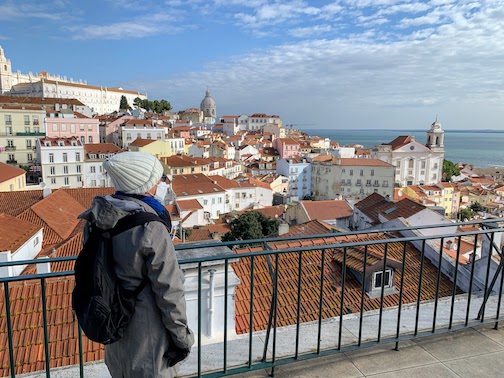
We stopped for a few minutes to admire the view at the Largo Santa Luzia. A small church one side of the square was decorated with two tile murals. One showed the royal palace in Lisbon on the Praça do Comércio as it looked before it was destroyed by the earthquake. The other depicted the reconquest of Lisbon, with Afonso Henriques and the Crusaders storming the gates of the castle.
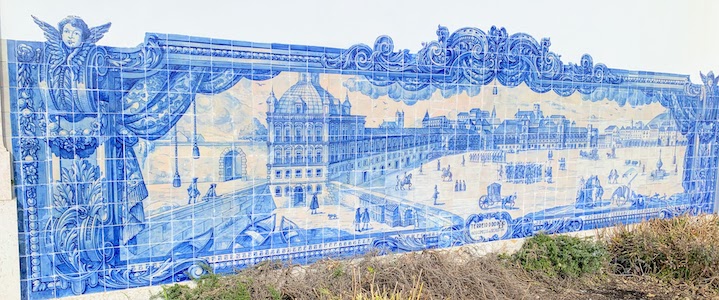
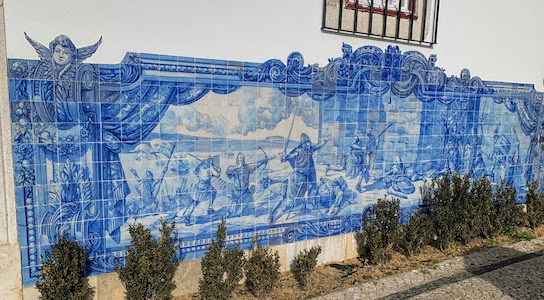
Just because we went down the hill slowly doesn’t mean everyone does. For several years there was an urban downhill bike race, known as the Lisboa Downtown, that sent riders barreling down the narrow streets, sometimes with unexpected results.
This gets gnarly at 1:53.
We’ve been unable to find any reference to this event since 2010, so we suspect it no longer happens.
The rest of the walk
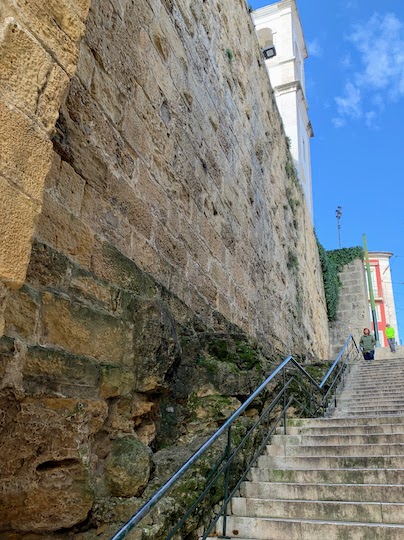
At one point on the walk down, we descended stairs next to the original fortified wall that marked the outer boundary of Moorish Lisbon. We had to stop and let the realization sink in that we were looking at a wall that was built over 1300 years ago.
There was some interesting street art to see as well. We saw this young lady from near the top of the hill, but got a closer look as we descended.
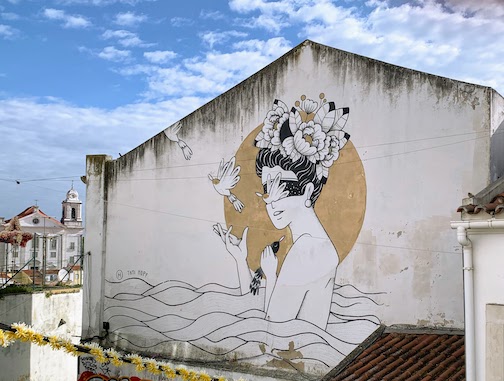
Then there was this one that we almost walked past without noticing.
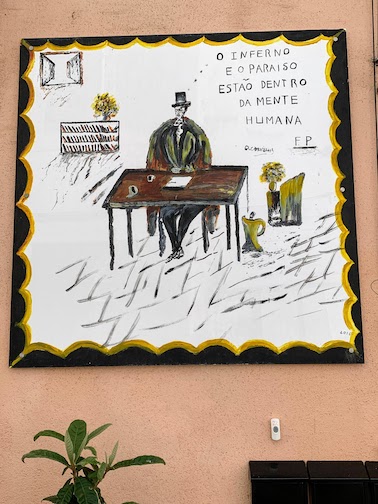
The text is a quote from the Portuguese poet Fernando Pessoa (1888 – 1935). Translated, it reads
Hell and paradise
They are within the human mind
Fernando could be pretty intense.
As we neared the bottom of the hill, we saw small groups of tourists starting up. We were happy that our guidebook had us start at the top!
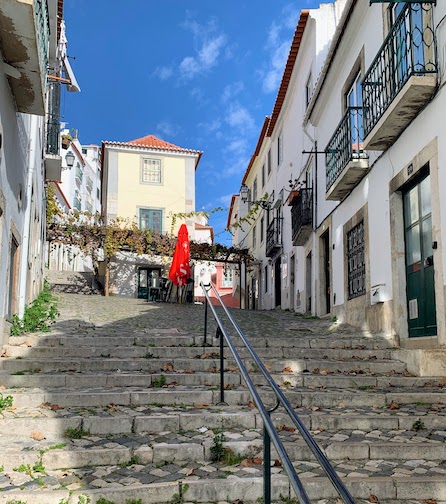
It’s Starting to Look Familiar
Our walking tour of Alfama gave us a good feel for the area. We’ll go back again later this year for one of the summer street festivals.
As we walked back to the train station, we saw some familiar places. We passed a street corner where we had looked at an apartment. We walked through the Praça Coméricial, past the Museu da Cerveja – Beer Museum (a story for another day). The Cais de Sodre train station is just across the street from the Time Out Market.
And along the way, we ran into these guys. They seemed awfully happy to see us.
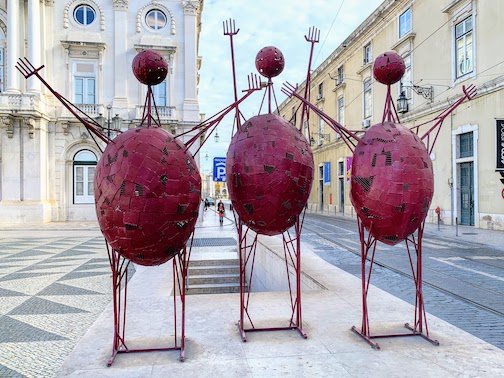
With these familiar landmarks, we now have a great jumping off point for future excursions into the city. There is so much to see and so much to learn about the history and culture. We’ll be busy for awhile.
What new place have you explored lately? Send us the coordinates and we’ll put a pin in our map. Or just tell us about it in the comments below or via the Contact form. We love a good travel story.
Have a great week! / Tenha uma ótima semana!
Mary and Mike
The Cook and The Writer
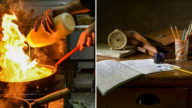

Love reading your adventure in Lisbon. Makes me want to visit it again. Keep exploring, we love hearing about it. Stay safe and warm❤️
We have a picture of Heather standing in front of that same door! Can’t wait to hear more about your new area. ?
Hi Dave (I’m guessing it’s you),
We saw at least one door that was even shorter! I’d have bruises on my forehead all the time if I lived in that neighborhood.
All the best
Mike
I love Lisboa. So happy to read about your fabulous adventures.
Hugs to you both,
Nan
Thanks, Nan!
I can’t wait to go visit.
John, we would be delighted to see the first stamp on your passport be from Portugal!